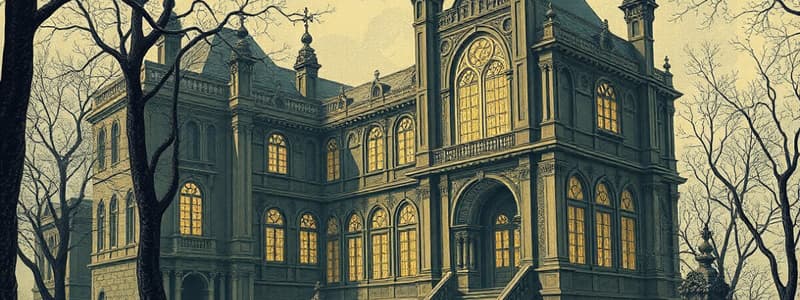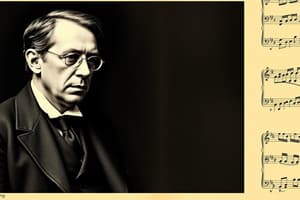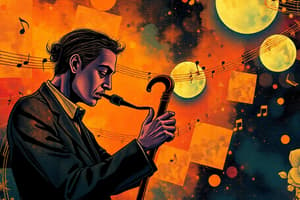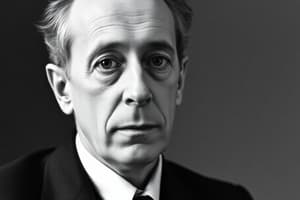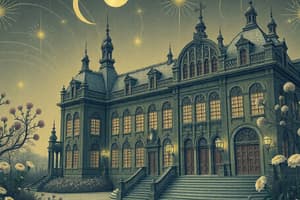Podcast
Questions and Answers
Which of the following best describes Schoenberg's initial professional path before fully dedicating himself to music?
Which of the following best describes Schoenberg's initial professional path before fully dedicating himself to music?
- He was a painter associated with Expressionist art.
- He worked as a lawyer to support his family.
- He was employed in a bank while studying music. (correct)
- He owned a shoe store like his father.
What was the significance of the Society for Private Musical Performances, founded by Schoenberg?
What was the significance of the Society for Private Musical Performances, founded by Schoenberg?
- It served as a school for aspiring conductors.
- It promoted only his own compositions.
- It was established to promote contemporary music. (correct)
- It aimed to preserve classical music traditions.
Which artistic movement, characterized by the use of vivid colors and shapes to express emotions, influenced Schoenberg's work?
Which artistic movement, characterized by the use of vivid colors and shapes to express emotions, influenced Schoenberg's work?
- Expressionist art (correct)
- Realism
- Impressionism
- Cubism
What is the central theme or subject of Schoenberg's Pierrot Lunaire?
What is the central theme or subject of Schoenberg's Pierrot Lunaire?
Which characteristic differentiates the West Indian steel drum from other drums listed?
Which characteristic differentiates the West Indian steel drum from other drums listed?
Which composer did Schoenberg meet early in his career, who significantly influenced his musical development?
Which composer did Schoenberg meet early in his career, who significantly influenced his musical development?
How did the rise of the Nazi government in Germany impact Arnold Schoenberg's life?
How did the rise of the Nazi government in Germany impact Arnold Schoenberg's life?
How does altering the tension of a drum's membrane affect its sound?
How does altering the tension of a drum's membrane affect its sound?
What is a defining characteristic of Gustav Mahler's symphonies that influenced Arnold Schoenberg?
What is a defining characteristic of Gustav Mahler's symphonies that influenced Arnold Schoenberg?
Which of the drums listed utilizes cords to modify its pitch during performance?
Which of the drums listed utilizes cords to modify its pitch during performance?
In what context are rattle drums primarily used by Indigenous people of North America?
In what context are rattle drums primarily used by Indigenous people of North America?
Which of the following is NOT true about Arnold Schoenberg's opera Moses and Aaron?
Which of the following is NOT true about Arnold Schoenberg's opera Moses and Aaron?
What physical property defines drums as membranophones?
What physical property defines drums as membranophones?
Which of the following drums is LEAST likely to be found in a modern orchestra?
Which of the following drums is LEAST likely to be found in a modern orchestra?
If a musician wants to emulate the sound of a 13th-century military band, which of the following instruments would be most appropriate?
If a musician wants to emulate the sound of a 13th-century military band, which of the following instruments would be most appropriate?
How does the pellet drum create sound?
How does the pellet drum create sound?
Arnold Schoenberg's Pierrot Lunaire is considered atonal because it:
Arnold Schoenberg's Pierrot Lunaire is considered atonal because it:
Which of the following statements best describes Schoenberg's motivation for developing new compositional techniques?
Which of the following statements best describes Schoenberg's motivation for developing new compositional techniques?
What is sprechstimme, as used in Pierrot Lunaire, and how is it indicated in the musical score?
What is sprechstimme, as used in Pierrot Lunaire, and how is it indicated in the musical score?
What does the term 'atonal' mean in the context of Schoenberg's Pierrot Lunaire?
What does the term 'atonal' mean in the context of Schoenberg's Pierrot Lunaire?
Schoenberg's Gurre-Lieder is notable for what characteristic?
Schoenberg's Gurre-Lieder is notable for what characteristic?
How did Schoenberg's creative expression evolve over time, considering his involvement in both music and painting?
How did Schoenberg's creative expression evolve over time, considering his involvement in both music and painting?
Schoenberg developed a system for composing with 12 notes. Which of the following is a key characteristic of this system?
Schoenberg developed a system for composing with 12 notes. Which of the following is a key characteristic of this system?
What was the general reception of Arnold Schoenberg's works during his lifetime?
What was the general reception of Arnold Schoenberg's works during his lifetime?
Flashcards
Arnold Schoenberg
Arnold Schoenberg
Austrian composer who developed the 12-tone system.
12-tone system
12-tone system
A system of musical composition using all 12 tones of the chromatic scale in a specific order to avoid a tonal center.
Expressionism
Expressionism
A style of art, literature, and music that seeks to express emotional experience rather than impressions of the external world.
Gustav Mahler
Gustav Mahler
Signup and view all the flashcards
Pierrot Lunaire
Pierrot Lunaire
Signup and view all the flashcards
Sprechstimme
Sprechstimme
Signup and view all the flashcards
Alban Berg & Anton Webern
Alban Berg & Anton Webern
Signup and view all the flashcards
Wassily Kandinsky
Wassily Kandinsky
Signup and view all the flashcards
Atonal
Atonal
Signup and view all the flashcards
Twelve-tone technique
Twelve-tone technique
Signup and view all the flashcards
Gurre-Lieder
Gurre-Lieder
Signup and view all the flashcards
Atonality
Atonality
Signup and view all the flashcards
Chromatic Scale notes
Chromatic Scale notes
Signup and view all the flashcards
Membranophones
Membranophones
Signup and view all the flashcards
Drum
Drum
Signup and view all the flashcards
Tsuzumi
Tsuzumi
Signup and view all the flashcards
Tabor
Tabor
Signup and view all the flashcards
Timpani
Timpani
Signup and view all the flashcards
Darbuka
Darbuka
Signup and view all the flashcards
Bongos
Bongos
Signup and view all the flashcards
West Indian Steel Drum
West Indian Steel Drum
Signup and view all the flashcards
Study Notes
- Arnold Schoenberg was a self-taught Austrian composer who revolutionized Western classical music in the 20th century.
- He prioritized expressing emotions and drama over composing for popular taste.
- Schoenberg faced criticism during his lifetime, but his work later inspired future composers.
Biography
- 1874: Schoenberg was born in the Jewish quarter of Vienna, Austria; his father owned a shoe store.
- 1883: He played the violin and composed by age nine.
- 1891: At 17, he worked in a bank to support his mother and fund evening music studies.
- 1894: He joined the Polyhymnia orchestra and met Alexander von Zemlinsky.
- 1895: Schoenberg left the bank to become a conductor and chorus master.
- 1898: At 24, he converted from Judaism to Protestantism.
- 1904: Schoenberg taught at Schwarzwald School; Alban Berg and Anton Webern were among his students, later embracing the 12-tone system.
- 1912: At age 38, he toured Europe and Russia as a conductor and lecturer; "Pierrot Lunaire" premiered successfully in Berlin.
- 1918: Schoenberg founded the Society for Private Musical Performances.
- 1933: At age 59, he fled Germany to the U.S. due to Nazi anti-Jewish policies.
- He became a professor at the University of California and gained U.S. citizenship in 1941.
- 1951: Schoenberg died at 77, leaving his 12-tone opera "Moses and Aaron" unfinished; his memorial is located in Vienna's Central Cemetery.
Musical Style and Influences
- Schoenberg developed new techniques to express emotions and drama in his music.
- Gustav Mahler (1860-1911), influenced him through the use of a large orchestra, theatrical contrasts and shifting parts.
- Expressionist art also influenced him; early 20th-century artists used vivid colors and shapes to express emotions.
Pierrot Lunaire
- "Pierrot Lunaire" is a series of German songs based on 21 poems by Albert Giraud (1884).
- A soprano, dressed as a sad clown, sings with a whitened face and loose black-and-white clothing.
- The piece is accompanied by five instruments.
- A strange, dreamlike voice part uses "sprechstimme," a technique blending speech and singing.
Atonality and the 12-Tone System
- Schoenberg moved away from traditional Western music, which is set in a key, to create atonal music.
- "Pierrot Lunaire" lacks a tonic and musical scale, creating unsettled feelings.
- Eight years later, he developed a system using all 12 notes in an octave, giving equal importance to each.
Other Endeavors
- From 1907, Schoenberg painted to express emotions; he later focused on music.
- He was a great tennis player playing with George Gershwin and also feared the number 13.
Gurre-Lieder
- "Gurre-Lieder" premiered in 1913.
- It is a cantata for orchestra, four choirs, five soloists, and a narrator.
- Set in a medieval Danish romantic and tragic legend by Jens Peter Jacobsen, about Gurre Castle in Denmark.
- In its creation, Schoenberg's composing style changed and matured.
Studying That Suits You
Use AI to generate personalized quizzes and flashcards to suit your learning preferences.
